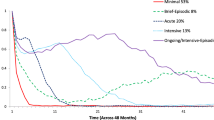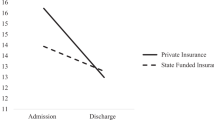Abstract
Our study represents a rural case management agency's use of its data to aid in its transition from being funded by federal grant funds to self-sustainment. We wanted to learn if some characteristics of those children served could predict the resources needed to serve them. We analyzed data on 90 children and adolescents living in a rural community. Using multiple regression analysis we found that CAFAS total and CBCL total problem scores predicted Medicaid reimbursements but not flexible funds spending or case management hours. History of psychiatric hospitalization, however, predicted flexible funds spending and case management hours. Using one-way ANOVA and post hoc analysis we found that the staff members' assessments of each child and family's level of service needs were reflected in differences in mean CAFAS total scores, Medicaid reimbursements and case management hours, but not CBCL total problem scores or flexible funds spending.
Similar content being viewed by others
REFERENCES
Achenbach, T. M. (1991). Manual checklist/4–18 and 1991 profile. Burlington, VT: University of Vermont Press.
Epstein, M. H., & Sharma, J. (1998). Behavioral and Emotional Rating Scale: A strength-based approach to assessment. Austin, TX: PRO-ED.
Hodges, K. (1996). CAFAS Manual for training coordinators, clinical administrators, and data managers. Ypsilanti, MI: Eastern Michigan University, Department of Psychology.
Hodges, K., Doucette-Gates, A., & Kim, C.-H. (2000). Predicting service utilization with the Child and Adolescent Functional Assessment Scale in a sample of youths with serious emotional disturbance served by Center for Mental Health Services-Funded Demonstrations. The Journal of Behavioral Health Services and Research, 27, 47–59.
Hodges, K., Doucette-Gates, A., & Liao, Q. (1999). The relationship between the Child and Adolescent Functional Assessment Scale (CAFAS) and indicators of functioning. Journal of Child and Family Studies, 8, 109–122.
Hodges, K., & Wong, M. M. (1997). Use of the Child and Adolescent Functional Assessment Scale to predict service utilization and cost. Journal of Mental Health Administration, 24, 278–290.
Kutash, K., & Rivera, V. R. (1996). What works in children's mental health services? Baltimore: Paul H. Brookes Publishing.
VanDenBerg, J. E., & Grealish, E. M. (1996). Individualized services and supports through the wraparound process: Philosophy and procedures. Journal of Child and Family Studies, 5, 7–22.
Woodbridge, M., & Huang, L. (2000). Using evaluation data to manage, improve, market and sustain children's services, Systems of Care: Promising Practices in Children's Mental Health, 2000 Series, Vol. II. Washington DC: Center for Effective Collaboration and Practice, American Institutes for Research.
Author information
Authors and Affiliations
Corresponding author
Rights and permissions
About this article
Cite this article
Jenson, C.E., Turner, W., Amero, S. et al. Predicting Resource Utilization by Children with Serious Emotional Disturbance and Their Families. Journal of Child and Family Studies 11, 361–371 (2002). https://doi.org/10.1023/A:1016828308458
Issue Date:
DOI: https://doi.org/10.1023/A:1016828308458




